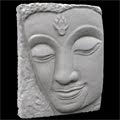We have recently uploaded some new videos of 3D scans captured using our innovative new scanning technology. This 3D scanning system gives us complete water-tight meshes with incredible detail and resolution. The system is ideal for digital archiving, reverse engineering, digitizing and much more. Stay tuned to Criteria Systems as we continue to break new ground in the field of 3D scanning and 3D scanning applications.
As with all of our scans, these models can be reproduced or reduced in size using our rapid prototyping system, or they can be enlarged for large format CNC production.
Monday, January 25, 2010
Monday, January 11, 2010
3D Scanning and Rapid Prototyping for Medical Purposes
3D Scanning and Rapid Prototyping at Criteria Systems are outstanding tools for medical applications.
For instance, The Walter Reed Army Medical Center in Washington, D.C. is using 3D rapid prototyping to create multi-color physical models of anatomy to aid in performing delicate surgeries.
Beginning with CT scans or photos, the institution’s 3D Medical Applications Center transforms them into 3D files, applies any color to the resulting digital models, and then uses a 3D printer to produce multicolor physical models. These models can be held in the hand and examined from all angles, which helps surgeons get a better idea of what issues they will need to know about during surgery. Currently, the center prints several of these models per week.
In particular, neurosurgeons have found the models useful as they make models of aneurysms and arterio-venous malformations to help them perform delicate surgeries. This way, surgeons report that they can know in advance the anatomical structures of the patient rather than discovering them after the incision is made, thus lessening the possibility of blood loss and chances of infections.
For orthopedic use, surgeons created a model for removal of bony growths on a patient’s knee. Surgeons used a 3D printer to print a white model of the joint with blood vessels illuminated in red and nerves in yellow, which gives the surgeon a roadmap to figure out the best route to address the tumors.
In one case, the surgeon used a sterile bag to transport his model into the operating room. He aligned his cutting instrument on the model, then aligned his instrument on the patient in the same manner.
For constructing facial prosthetic models, a 3D printed mask is used in anaplastology to avoid the process of plaster on patients’ faces used to produce a moulage casting.
For more information, visit http://www.criteria-systems.com.
For instance, The Walter Reed Army Medical Center in Washington, D.C. is using 3D rapid prototyping to create multi-color physical models of anatomy to aid in performing delicate surgeries.
Beginning with CT scans or photos, the institution’s 3D Medical Applications Center transforms them into 3D files, applies any color to the resulting digital models, and then uses a 3D printer to produce multicolor physical models. These models can be held in the hand and examined from all angles, which helps surgeons get a better idea of what issues they will need to know about during surgery. Currently, the center prints several of these models per week.
In particular, neurosurgeons have found the models useful as they make models of aneurysms and arterio-venous malformations to help them perform delicate surgeries. This way, surgeons report that they can know in advance the anatomical structures of the patient rather than discovering them after the incision is made, thus lessening the possibility of blood loss and chances of infections.
For orthopedic use, surgeons created a model for removal of bony growths on a patient’s knee. Surgeons used a 3D printer to print a white model of the joint with blood vessels illuminated in red and nerves in yellow, which gives the surgeon a roadmap to figure out the best route to address the tumors.
In one case, the surgeon used a sterile bag to transport his model into the operating room. He aligned his cutting instrument on the model, then aligned his instrument on the patient in the same manner.
For constructing facial prosthetic models, a 3D printed mask is used in anaplastology to avoid the process of plaster on patients’ faces used to produce a moulage casting.
For more information, visit http://www.criteria-systems.com.
Labels:
3D scanning,
criteria systems,
medical models,
rapid prototype
Subscribe to:
Posts (Atom)


